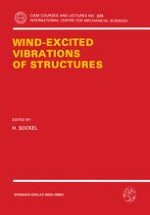1994 | OriginalPaper | Chapter
Fundamentals of Wind Engineering
Author : H. Sockel
Published in: Wind-Excited Vibrations of Structures
Publisher: Springer Vienna
Included in: Professional Book Archive
Activate our intelligent search to find suitable subject content or patents.
Select sections of text to find matching patents with Artificial Intelligence. powered by
Select sections of text to find additional relevant content using AI-assisted search. powered by
The atmospheric wind is an unsteady, viscous flow field with irregular changes called a turbulent flow. In chapter 2 there are discussed the basic equations of fluid dynamics for such a flow. For characterizing a turbulent flow there are used time averaged quantities of velocity and pressure and of products of the fluctuations of these quantities and power spectra.s, what is described in chapter 3 generally and in the following chapter especially for the atmospheric boundary layer. Since the probability of the occurrence of a wind velocity in a given interval of time is very important for the safety of a structure, there is one section dealing with wind statistics. Chapters 5 and 6 inform about the flow around rigid bluff bodies, pressure distributions and forces caused by the flow. The following chapter deals with the fundamentals for single-degree and multi-degree of freedom linear dynamic systems. Since the interaction of a wind field and a structure is a very complex problem, model experiments are necessary too. The experimental technique in an artificial boundary layer, in an atmospheric wind tunnel, is discussed in the last chapter, including similarity rules and measurement techniques.
